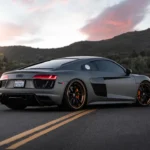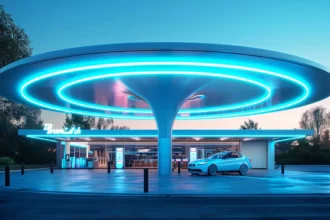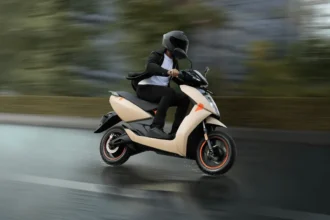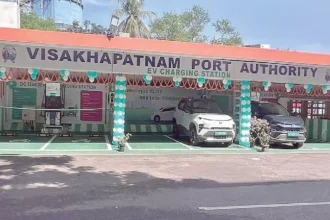India’s Electric Vehicle Journey: Which States Are Leading the Way?
Have you noticed more electric cars and scooters on Indian roads lately? The numbers show a big change is happening. According to autocarpro and rushlane, Uttar Pradesh is now leading the race with over 377,000 electric vehicles (EVs) registered in 2024-25. This exciting shift toward cleaner transportation is happening across different states at varying speeds.
When experts look at how fast Indians are adopting electric vehicles, they track two main numbers: how many EVs exist per 1,000 people (showing how common they are) and what percentage of all vehicles sold are electric (showing market growth).
Which States Have the Most Electric Vehicles?
The top seven states account for about 64% of all electric vehicles sold in India. This shows that EV adoption is still concentrated in certain regions rather than spread evenly across the country.
| State Position | State Name | Total EVs (2024-25) | EVs per 1,000 People | Percentage of All Vehicles |
|---|---|---|---|---|
| 1 | Uttar Pradesh | 377,526 | 1.58 | ~2.5% |
| 2 | Maharashtra | 246,221 | 1.93 | ~2.2% |
| 3 | Karnataka | 173,559 | 2.54 | ~2.4% |
| 4 | Tamil Nadu | 137,699 | 1.75 | ~1.6% |
| 5 | Bihar | 120,561 | 0.92 | ~2.1% |
| 6 | Rajasthan | 106,963 | 1.30 | ~2.0% |
| 7 | Madhya Pradesh | 100,314 | 1.14 | ~1.5% |
This data comes from Vahan records as reported by autocarpro and rushlane, with population figures from statisticstimes.com. What’s interesting is that while Uttar Pradesh has the highest total number of EVs, Karnataka actually has the most EVs per person among major states.
What These Numbers Really Mean
The “EVs per 1,000 people” number helps you understand how common electric vehicles are in everyday life. Think of it like this: if you gathered 1,000 random people in Karnataka, about 2-3 of them would own an electric vehicle.
The “percentage of all vehicles” shows how many people are choosing electric when buying new vehicles. In India overall, about 7-8% of all new vehicles sold are now electric, according to autocarpro.in.
How Does India Compare to Other Countries?
When you look at global numbers, India’s EV journey is just beginning compared to some countries. Here’s how we stack up against world leaders:
| Country/Region | Total EVs on Road (2023) | EVs per 1,000 People | New Car Sales % Electric (2024) |
|---|---|---|---|
| China | ~20.4 million | ~11.0 | ~45% |
| Europe (EU) | ~11.8 million | ~7.0 | ~25% |
| USA | ~4.7 million | ~14.2 | ~11% |
| India | ~2 million | ~1.4 | ~7-8% |
| World | ~40.0 million | – | ~20% |
Data sources: en.wikipedia.org for total EVs, statzon.com for global total, and iea.org for market share percentages. The gap between India and global leaders is still quite large, but our growth rate is picking up speed.
Government Policies Pushing Electric Vehicle Growth
Why are more people buying electric vehicles in certain states? The answer often comes down to government support. Here are some key policies making a difference:
- National Support: The FAME India Scheme Phase-II is helping more people buy electric vehicles and building charging stations across the country, according to PiB.
- Uttar Pradesh’s Approach: Their policy runs until 2027 and gives buyers money back when they purchase EVs – from ₹6,000 for two-wheelers up to ₹1 lakh for cars.
- Maharashtra’s Big Investment: Their EV Policy 2025 has set aside ₹2,000 crore and includes purchase money back plus no toll fees on major highways, according to TOI.
- Registration Benefits: Maharashtra’s policy also removes registration fees and is building many charging stations.
- Extra State Help: According to EVfy, states like Maharashtra, Goa, Gujarat, West Bengal, and Assam give extra money beyond the national FAME-II program.
- Tax Savings: These states also don’t charge road tax or registration fees, making electric vehicles more affordable for everyday people.
Which Types of Electric Vehicles Are Most Popular?
Not all electric vehicles are the same, and some types are selling better than others. According to Upevsubsidy, EV registrations include different categories like two-wheelers, three-wheelers, cars, and buses.
- Two-Wheeler Dominance: Electric scooters and motorcycles were the biggest segment in FY2025, making up more than half of all EV sales in India, according to Entreprenuer.
- Three-Wheeler Strength: Passenger electric three-wheelers (like auto-rickshaws) came in second place nationwide, as reported by Entreprenuer.
- State Leadership Patterns: AutoCar pro reports that Uttar Pradesh led in total registrations largely because of electric three-wheelers, controlling 38% of the national market for this segment.
- Maharashtra’s Diverse Success: This state topped retail sales for electric two-wheelers, cars/SUVs, and commercial vehicles including buses in FY2025, according to AutoCar pro.
- Data Tracking: EVReporter identifies the Vahan Dashboard as the main source for tracking EV registration numbers and seeing which vehicle types are growing fastest.
Understanding the EV Growth Story
The numbers show that while India’s electric vehicle adoption is still in early stages compared to global leaders, we’re seeing steady growth. With about 7-8% of new vehicles being electric, India is building momentum.
Think of it like this: if you gathered 100 people who just bought new vehicles in India, about 7 or 8 of them would have chosen electric options. In China, that number would be around 45 people.
As charging stations become more common and government support continues, your next vehicle might well be electric. The road to widespread EV adoption in India is just beginning, but the direction is clear.











